
Ardfert is a village and civil parish in County Kerry, Ireland. Historically a religious centre, the economy of the locality is driven by agriculture and its position as a dormitory town, being only 8 km (5 mi) from Tralee. The population of the village was 749 at the 2016 census.
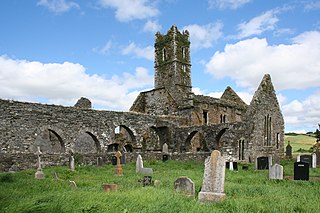
Timoleague Friary, also known as Timoleague Abbey, is a ruined medieval Franciscan friary in Timoleague, County Cork, Ireland, on the banks of the Argideen River overlooking Courtmacsherry Bay. It was built on the site of an early Christian monastic site founded by Saint Molaga, from whom the town of Timoleague derives its name. The present remains date from roughly the turn of the fourteenth century and were burnt down by British forces in the mid-seventeenth century, at which point it was an important ecclesiastical centre that engaged in significant trade with Spain.

Kilcrea Friary is a ruined medieval abbey located near Ovens, County Cork, Ireland. Both the friary and Kilcrea Castle, located in ruin to the west, were built by Observant Franciscans in the mid 15th century under the invitation of Cormac Láidir MacCarthy, Lord of Muskerry, as protection from English troops.

Ballylongford is a village near Listowel in northern County Kerry, Ireland. As of the 2022 census, it had a population of 415.

The Buttevant Franciscan Friary is a ruined 13th-century Franciscan friary is situated in the middle of the town of Buttevant, County Cork, Ireland. The Augustinian friary in nearby Ballybeg is often confused with the Buttevant Franciscan Friary in historical documents.

Multyfarnham or Multyfarnam is a village in County Westmeath, Ireland. As of the 2022 census, it had a population of 460 people.

The French Church, also known as Greyfriars Abbey, is a former Franciscan friary which was built in 1241 on what is now Greyfriars and Baileys New Street, Waterford in Ireland. At the entrance to the ancient church stands a monument to Luke Wadding, a seventeenth-century Waterford-born priest. This friary was one of the first to be built in Ireland, being founded by the Anglo-Norman Knight Sir Hugh Purcell.
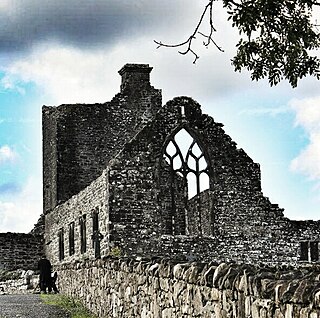
Creevelea Abbey is an early 16th-century Franciscan friary and National Monument located in Dromahair, County Leitrim, Ireland. Although in ruins, Creevelea Abbey is still in use as a grave yard.

Strade Abbey is a former Franciscan/Dominican monastery and National Monument located in County Mayo, Ireland.
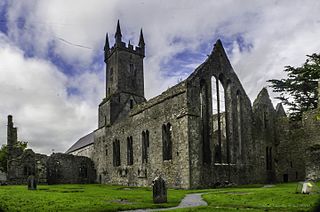
Ennis Friary was a Franciscan friary in the town of Ennis, County Clare, Ireland. It was established in the middle of the 13th century by the ruling O'Brien dynasty who supported it for most of its existence. Following the suppression of the monasteries in the 16th century, the friary continued to function for a while despite the loss of its lands. In the early 17th century, the buildings were handed over to the Church of Ireland as a place of worship. It was used as such until the late 19th century. After the construction of a new Church of Ireland building, the friary fell into ruin. Managed by the Office of Public Works since the late 19th century, it was formally returned to the Franciscan Order in 1969.

The Priory of the Holy Cross, also called Rathfran Friary or Rathfran Priory, is a former Dominican Friary and National Monument located in County Mayo, Ireland.

Castlelyons Friary is a former Carmelite Priory and National Monument located in County Cork, Ireland.

Ardfert Abbey, also known as Ardfert Friary, is a ruined medieval Franciscan friary and National Monument in Ardfert, County Kerry, Ireland. It is thought to be built on the site of an early Christian monastic site founded by Brendan the Navigator. The present remains date from the mid-thirteenth century, with the residential tower being added in the 15th century. The friary was dissolved in 1584.
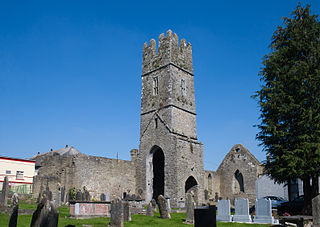
Roscrea Friary is a ruined medieval Franciscan friary and National Monument located in Roscrea, County Tipperary, Ireland. It is on Abbey Street, in the west end of Roscrea, on the north bank of the River Bunnow. The Friary was founded in the 15th century by Greyfriars (Franciscans) and later destroyed by British soldiers. What remains are the north and east walls and the bell-tower.

Portumna Abbey is a medieval Cistercian friary and National Monument located in Portumna, Ireland.

Kinalehin Friary, originally a medieval charterhouse or Carthusian monastery and later a Franciscan friary, is a National Monument located in County Galway, Ireland.
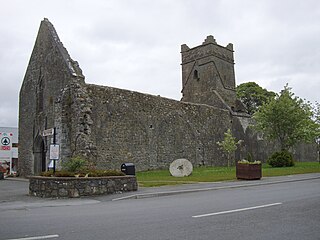
Dunmore Abbey is a medieval Augustinian friary and national monument located in County Galway, Ireland.
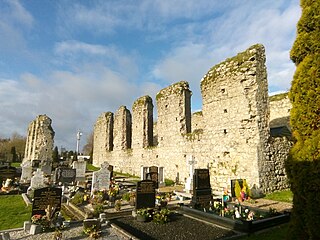
Clane Friary, also called Clane Abbey, is a former friary of the Order of Friars Minor Conventual located in Clane, Ireland.

Askeaton Abbey or Askeaton Friary is a ruined medieval Franciscan friary located north of Askeaton, County Limerick, Ireland, on the east bank of the River Deel.

Iraghticonnor is a historical barony in northeastern County Kerry, Ireland.























